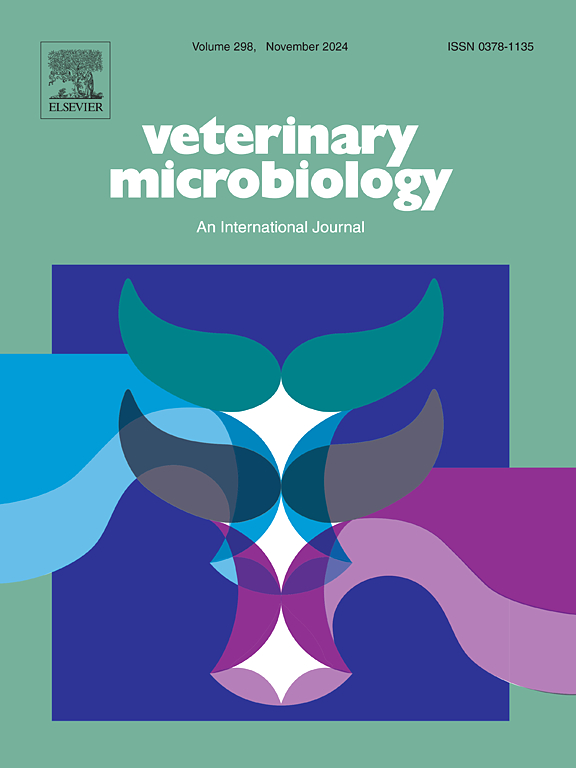Proteome profiling of the lung tissues of the mice co-infected with H9N2 influenza A virus and Pseudomonas aeruginosa
IF 2.4
2区 农林科学
Q3 MICROBIOLOGY
引用次数: 0
Abstract
H9N2 Influenza A virus (IAV) can contribute to Pseudomonas aeruginosa (P. aeruginosa) superinfection, causing severe pneumonia. But the underlying mechanisms remain unclear. In this study, to investigate molecular ecology of the lung tissues co-infected with H9N2 IAV and P. aeruginosa, the mouse models were developed to analyze proteome of the lung tissues. As a result, the differential proteins of the lungs sampled from the mice with single H9N2 IAV infection, single P. aeruginosa infection and co-infection with H9N2 IAV and P. aeruginosa were related to immune responses, cell proliferation and apoptosis, which were involved in NF-κB pathway, Toll-like signaling pathway, RIG-I signaling pathway and JAK-STAT signaling pathway. It implied that the different infection combinations of H9N2 IAV and P. aeruginosa influenced the protein expression levels. Based on the proteomics assays, the three proteins, NLRX1, ISG15 and IRF9, were screened to be further characterized using the in vitro MH-S cell models with H9N2 IAV and P. aeruginosa co-infection. The findings demonstrated that NLRX1, IRF9 and ISG15 might play the important roles in immune response against H9N2 IAV and P. aeruginosa co-infection and are potential targets for the development of drugs to prevent and treat the diseases.
H9N2甲型流感病毒和铜绿假单胞菌共感染小鼠肺组织的蛋白质组学分析
H9N2甲型流感病毒(IAV)可导致铜绿假单胞菌(P. aeruginosa)重复感染,导致严重肺炎。但其潜在机制尚不清楚。本研究为研究H9N2 IAV和P. aeruginosa共感染肺组织的分子生态学,建立小鼠模型,分析肺组织的蛋白质组学。结果表明,单独感染H9N2 IAV、单独感染P. aeruginosa以及H9N2 IAV和P. aeruginosa合并感染小鼠肺组织的差异蛋白与免疫应答、细胞增殖和凋亡有关,涉及NF-κB通路、toll样信号通路、RIG-I信号通路和JAK-STAT信号通路。提示不同感染组合的H9N2 IAV和P. aeruginosa影响了蛋白表达水平。在蛋白质组学分析的基础上,筛选了NLRX1、ISG15和IRF9 3个蛋白,并利用H9N2 IAV和铜绿假单胞菌共感染的MH-S细胞模型进行了进一步的表征。研究结果表明,NLRX1、IRF9和ISG15可能在H9N2 IAV和P. aeruginosa共感染的免疫应答中发挥重要作用,是开发预防和治疗疾病药物的潜在靶点。
本文章由计算机程序翻译,如有差异,请以英文原文为准。
求助全文
约1分钟内获得全文
求助全文
来源期刊

Veterinary microbiology
农林科学-兽医学
CiteScore
5.90
自引率
6.10%
发文量
221
审稿时长
52 days
期刊介绍:
Veterinary Microbiology is concerned with microbial (bacterial, fungal, viral) diseases of domesticated vertebrate animals (livestock, companion animals, fur-bearing animals, game, poultry, fish) that supply food, other useful products or companionship. In addition, Microbial diseases of wild animals living in captivity, or as members of the feral fauna will also be considered if the infections are of interest because of their interrelation with humans (zoonoses) and/or domestic animals. Studies of antimicrobial resistance are also included, provided that the results represent a substantial advance in knowledge. Authors are strongly encouraged to read - prior to submission - the Editorials (''Scope or cope'' and ''Scope or cope II'') published previously in the journal. The Editors reserve the right to suggest submission to another journal for those papers which they feel would be more appropriate for consideration by that journal.
Original research papers of high quality and novelty on aspects of control, host response, molecular biology, pathogenesis, prevention, and treatment of microbial diseases of animals are published. Papers dealing primarily with immunology, epidemiology, molecular biology and antiviral or microbial agents will only be considered if they demonstrate a clear impact on a disease. Papers focusing solely on diagnostic techniques (such as another PCR protocol or ELISA) will not be published - focus should be on a microorganism and not on a particular technique. Papers only reporting microbial sequences, transcriptomics data, or proteomics data will not be considered unless the results represent a substantial advance in knowledge.
Drug trial papers will be considered if they have general application or significance. Papers on the identification of microorganisms will also be considered, but detailed taxonomic studies do not fall within the scope of the journal. Case reports will not be published, unless they have general application or contain novel aspects. Papers of geographically limited interest, which repeat what had been established elsewhere will not be considered. The readership of the journal is global.
 求助内容:
求助内容: 应助结果提醒方式:
应助结果提醒方式:


